Villeroy & Boch Bundle
How Did Villeroy & Boch Become a Global Icon?
Journey back in time to 1748 and uncover the captivating Villeroy & Boch SWOT Analysis, a story of ceramic innovation and enduring design. From its humble beginnings as a pottery workshop, Villeroy & Boch has evolved into a global leader, shaping living spaces with its exquisite tableware, bathrooms, and tiles. Explore the key milestones and strategic decisions that have solidified its place in history.
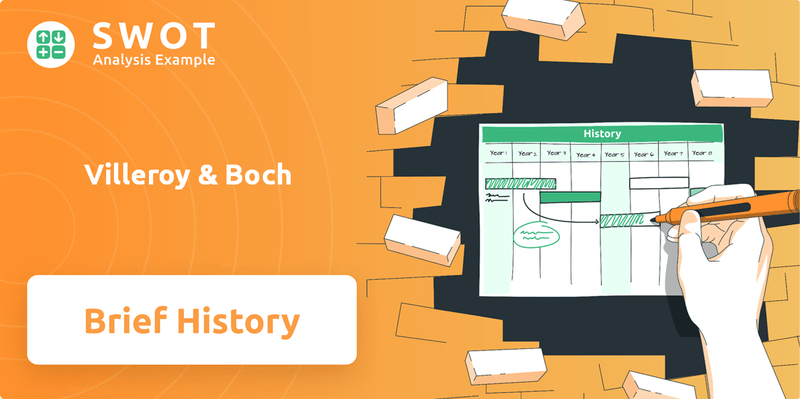
This brief history of Villeroy & Boch explores the company's fascinating evolution, highlighting its German origins and Luxembourg roots. Discover how Villeroy & Boch, a name synonymous with quality and craftsmanship, transformed from a small workshop into an international powerhouse. Learn about the key moments and the impact of Villeroy & Boch on the world of ceramics, and how its commitment to design has shaped its legacy.
What is the Villeroy & Boch Founding Story?
The story of the Villeroy & Boch history officially began on February 28, 1748, marking the founding of the company. François Boch, along with his three sons, Jean-François, Joseph, and Pierre, established the foundation for what would become a global brand. Their initial focus was on creating affordable ceramic tableware, tapping into the growing demand for alternatives to luxury porcelain.
Originating from Audun-le-Tiche, Lorraine, France, the Boch family transitioned from iron casting to ceramic production. This shift was driven by the vision to produce everyday items that combined functionality with aesthetic appeal. Their early efforts centered on earthenware, including plates and dishes, crafted in a small workshop, showcasing their commitment to quality from the start.
The company's evolution, including its early years, saw a pivotal merger in 1836 with Nicolas Villeroy's faience factory, which significantly expanded its production capabilities and market reach. Initial funding for the Boch family's venture was largely self-funded, relying on family resources and reinvested profits. This self-reliance highlighted their determination to build a sustainable business. The company's early success was also marked by the innovative spirit of the Bochs, particularly their adoption of new firing techniques and decorative methods, which allowed them to produce ceramics of superior quality and design.
The founding of the company was a pivotal moment in the history of ceramics.
- 1748: Founding Date.
- François Boch and his sons began producing earthenware.
- The merger with Nicolas Villeroy's factory in 1836 was a key milestone.
- Early focus on innovation in firing and design.
Villeroy & Boch SWOT Analysis
- Complete SWOT Breakdown
- Fully Customizable
- Editable in Excel & Word
- Professional Formatting
- Investor-Ready Format
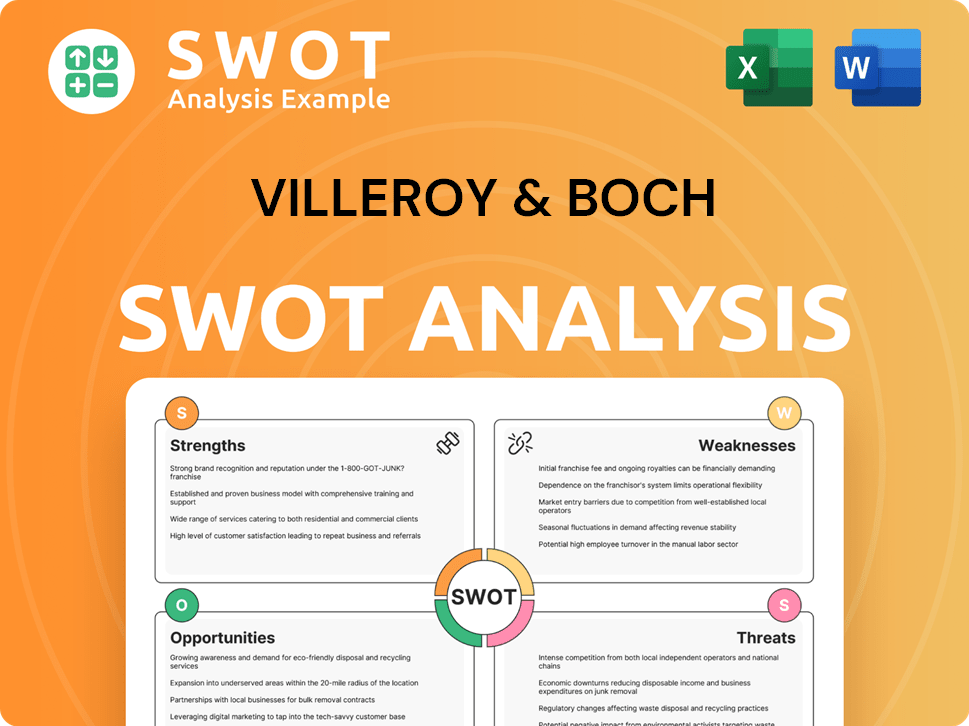
What Drove the Early Growth of Villeroy & Boch?
The early growth of the Villeroy & Boch company was marked by strategic mergers, product diversification, and geographical expansion, setting the stage for its future success. Following the 1836 merger, the company combined the strengths of Jean-François Boch's pottery and Nicolas Villeroy's faience factory. This union increased production capacity and broadened the product range, which included a variety of tableware designs that quickly gained popularity across Europe.
The mid-19th century saw significant expansion, with the Mettlach Abbey becoming a central, mechanized factory for Villeroy & Boch. This move towards industrialization allowed for greater output and consistency. The company also began expanding its sales network beyond its immediate region into other parts of Germany and neighboring European countries, marking the beginning of its geographical expansion.
By the late 19th century, Villeroy & Boch diversified beyond tableware into sanitary ceramics and tiles, recognizing the growing demand for improved hygiene. This strategic shift broadened their market reach and solidified their position as a comprehensive ceramic manufacturer. This expansion into new product categories and geographical regions laid the groundwork for its future success and global presence.
The company's growth efforts were met with positive market reception, as their products offered a blend of durability, functionality, and artistic merit. Despite a competitive landscape, Villeroy & Boch's consistent innovation and quality allowed them to maintain a leading edge. The company's ability to adapt and innovate during this time was critical to its long-term success.
Early capital raises, largely through reinvested profits and private funding, fueled further expansion and technological advancements. Leadership transitions within the founding families ensured continuity and a shared vision for growth. These financial strategies were crucial in supporting the company's ambitious expansion plans and maintaining its competitive advantage.
Villeroy & Boch PESTLE Analysis
- Covers All 6 PESTLE Categories
- No Research Needed – Save Hours of Work
- Built by Experts, Trusted by Consultants
- Instant Download, Ready to Use
- 100% Editable, Fully Customizable
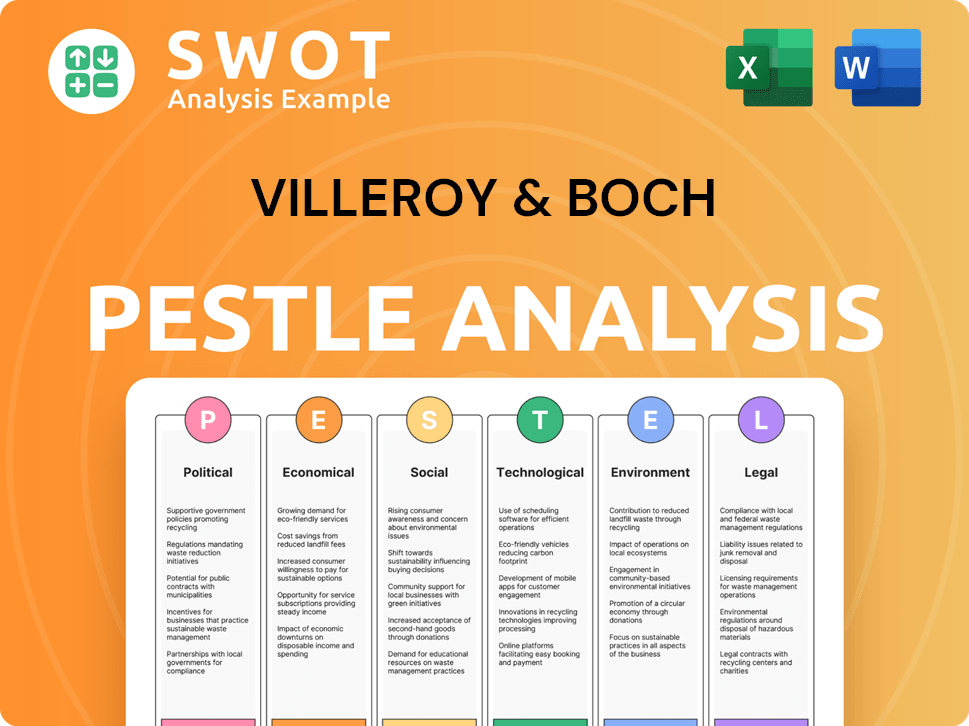
What are the key Milestones in Villeroy & Boch history?
The Villeroy & Boch company has a rich history filled with significant milestones that have shaped its identity and success. From its
German origins
to global recognition, the company's journey is marked by strategic decisions and innovations.| Year | Milestone |
|---|---|
| 1748 | François Boch and Nicolas Villeroy establish their respective businesses, laying the foundation for the future Villeroy & Boch. |
| 1836 | The merger of the Boch and Villeroy families marks the official founding of Villeroy & Boch. |
| Mid-19th Century | Development of the highly sought-after Mettlach tiles, a groundbreaking innovation for the company. |
| 1851 | Villeroy & Boch showcases its innovations at the Great Exhibition in London, gaining international recognition. |
| Early 20th Century | The company expands its product range and distribution network, adapting to changing market demands. |
| Post-World War II | Villeroy & Boch focuses on reconstruction efforts and adapts production to meet societal needs. |
| Present | The company continues to innovate and expand its product lines, maintaining its position as a leading brand in tableware, bathroom, and wellness products. |
The
Villeroy & Boch
company's success is significantly attributed to its continuous innovations in ceramics and design. These advancements have not only enhanced the aesthetic appeal of their products but have also improved their durability and functionality.The development of Mettlach tiles in the mid-19th century was a groundbreaking innovation, known for their durability and intricate designs.
Securing numerous patents for ceramic processes and designs demonstrated a commitment to technological advancement and protecting intellectual property.
Partnerships with renowned artists and designers elevated the aesthetic appeal of products, enhancing the brand's prestige.
Continuous investment in research and development has led to improvements in manufacturing processes and product quality.
The company consistently introduces new designs and collections, reflecting current trends while maintaining brand heritage.
Exploration of new materials and techniques enhances product durability, aesthetics, and functionality.
Throughout its history, the
Villeroy & Boch company
has faced various challenges that have tested its resilience. These obstacles have prompted strategic adaptations and innovations to maintain market position.The two World Wars severely impacted production and distribution, leading to market downturns and facility destruction.
Competition from lower-cost manufacturers in the 20th century challenged the company's market share and profitability.
Experimental product lines that did not resonate with consumers provided insights into market demand and design preferences.
Economic downturns necessitated restructuring efforts, including rebranding initiatives and leadership changes.
Internal crises, such as labor disputes, required strategic management to streamline operations and regain market footing.
Changing consumer preferences and trends necessitated continuous adaptation in design, product lines, and marketing strategies.
Villeroy & Boch Business Model Canvas
- Complete 9-Block Business Model Canvas
- Effortlessly Communicate Your Business Strategy
- Investor-Ready BMC Format
- 100% Editable and Customizable
- Clear and Structured Layout
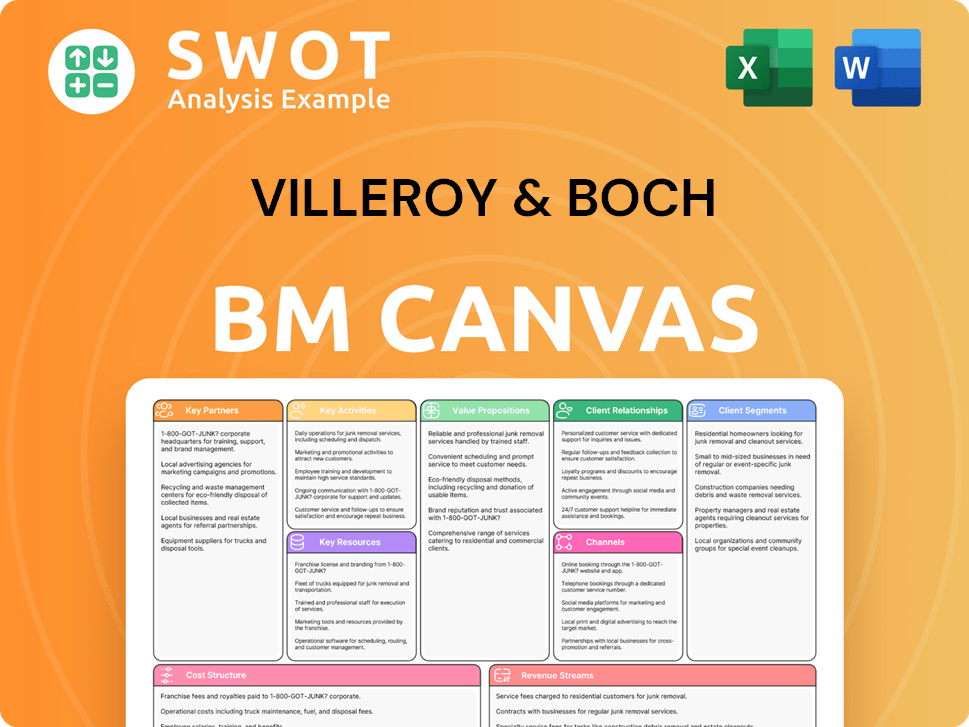
What is the Timeline of Key Events for Villeroy & Boch?
The Villeroy & Boch history is marked by significant milestones, evolving from a pottery workshop to a global brand. From its 1748 origins in Audun-le-Tiche, France, where François Boch established a pottery workshop, to the merger in 1836 that formed the company, Villeroy & Boch has adapted and expanded its product lines. The introduction of Mettlach tiles in the mid-19th century and expansion into sanitary ceramics later broadened its offerings. International expansion in the early 20th century and a focus on design innovation in the late 20th century, along with market diversification and a commitment to sustainability in the 21st century, highlight its enduring legacy.
| Year | Key Event |
|---|---|
| 1748 | François Boch establishes a pottery workshop in Audun-le-Tiche, Lorraine, France, marking the company's origins. |
| 1809 | Jean-François Boch acquires the Mettlach abbey, transforming it into a ceramic factory. |
| 1836 | The merger with Nicolas Villeroy's faience factory forms Villeroy & Boch. |
| Mid-19th Century | Introduction of 'Mettlach tiles,' known for their quality and intricate designs. |
| Late 19th Century | Expansion into sanitary ceramics and tiles, broadening the product portfolio. |
| Early 20th Century | International expansion and establishment of sales offices worldwide. |
| 1970s-1980s | Focus on design innovation and premium product lines. |
| 1990s | Expansion into new markets, particularly in Asia. |
| 2000s | Emphasis on sustainability and eco-friendly production. |
| 2023 | Villeroy & Boch reports strong financial performance, especially in its Bathroom and Wellness division. |
| 2024 | Strategic investments in automation and digitalization are announced. |
Villeroy & Boch continues to prioritize innovation in smart home solutions and sustainable materials. Research and development focus on new ceramic compounds and water-saving technologies. This aligns with consumer demand for bespoke solutions and eco-friendly products, ensuring a future-ready product line.
The company plans to strengthen its presence in high-growth regions. The focus will be on Asia and the Middle East, while maintaining its strong foothold in Europe. This strategic approach will help Villeroy & Boch to expand its global market share and reach new customers.
Digitalization of sales and marketing remains a key focus, with an emphasis on e-commerce and personalized customer experiences. This includes enhanced online platforms and digital marketing strategies. Digital transformation is essential for customer engagement.
Analyst predictions suggest continued robust performance, supported by strong brand recognition and a diversified product portfolio. In 2023, the Bathroom and Wellness division significantly contributed to the company's revenue. The company's forward-looking statement ties back to its founding vision by continuing to create functional and decorative products that enhance living spaces worldwide.
Villeroy & Boch Porter's Five Forces Analysis
- Covers All 5 Competitive Forces in Detail
- Structured for Consultants, Students, and Founders
- 100% Editable in Microsoft Word & Excel
- Instant Digital Download – Use Immediately
- Compatible with Mac & PC – Fully Unlocked
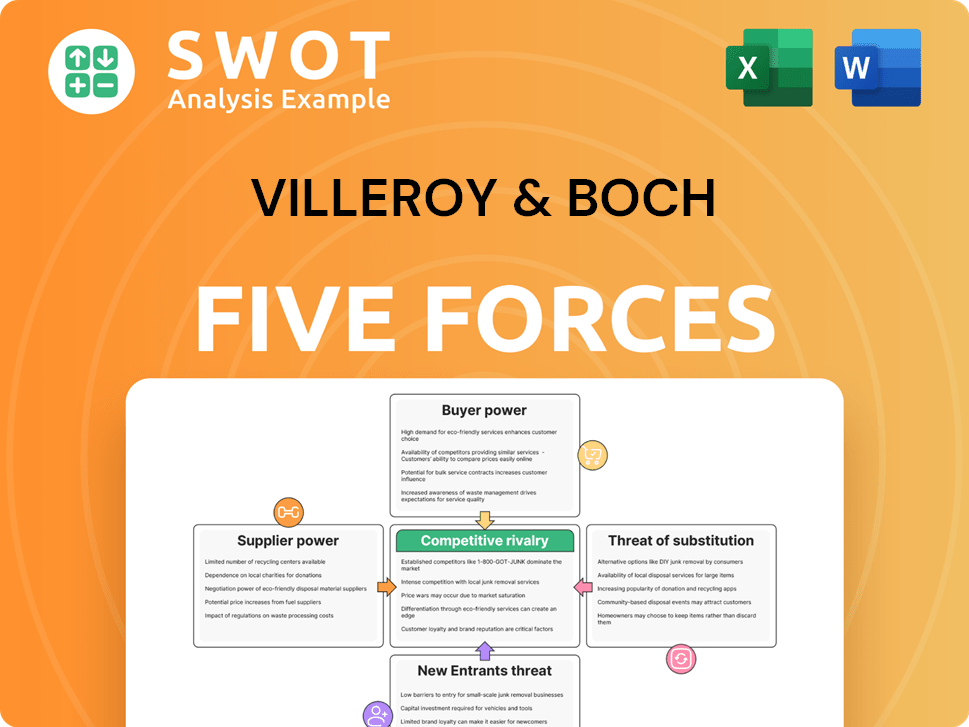
Related Blogs
- What is Competitive Landscape of Villeroy & Boch Company?
- What is Growth Strategy and Future Prospects of Villeroy & Boch Company?
- How Does Villeroy & Boch Company Work?
- What is Sales and Marketing Strategy of Villeroy & Boch Company?
- What is Brief History of Villeroy & Boch Company?
- Who Owns Villeroy & Boch Company?
- What is Customer Demographics and Target Market of Villeroy & Boch Company?
Disclaimer
All information, articles, and product details provided on this website are for general informational and educational purposes only. We do not claim any ownership over, nor do we intend to infringe upon, any trademarks, copyrights, logos, brand names, or other intellectual property mentioned or depicted on this site. Such intellectual property remains the property of its respective owners, and any references here are made solely for identification or informational purposes, without implying any affiliation, endorsement, or partnership.
We make no representations or warranties, express or implied, regarding the accuracy, completeness, or suitability of any content or products presented. Nothing on this website should be construed as legal, tax, investment, financial, medical, or other professional advice. In addition, no part of this site—including articles or product references—constitutes a solicitation, recommendation, endorsement, advertisement, or offer to buy or sell any securities, franchises, or other financial instruments, particularly in jurisdictions where such activity would be unlawful.
All content is of a general nature and may not address the specific circumstances of any individual or entity. It is not a substitute for professional advice or services. Any actions you take based on the information provided here are strictly at your own risk. You accept full responsibility for any decisions or outcomes arising from your use of this website and agree to release us from any liability in connection with your use of, or reliance upon, the content or products found herein.